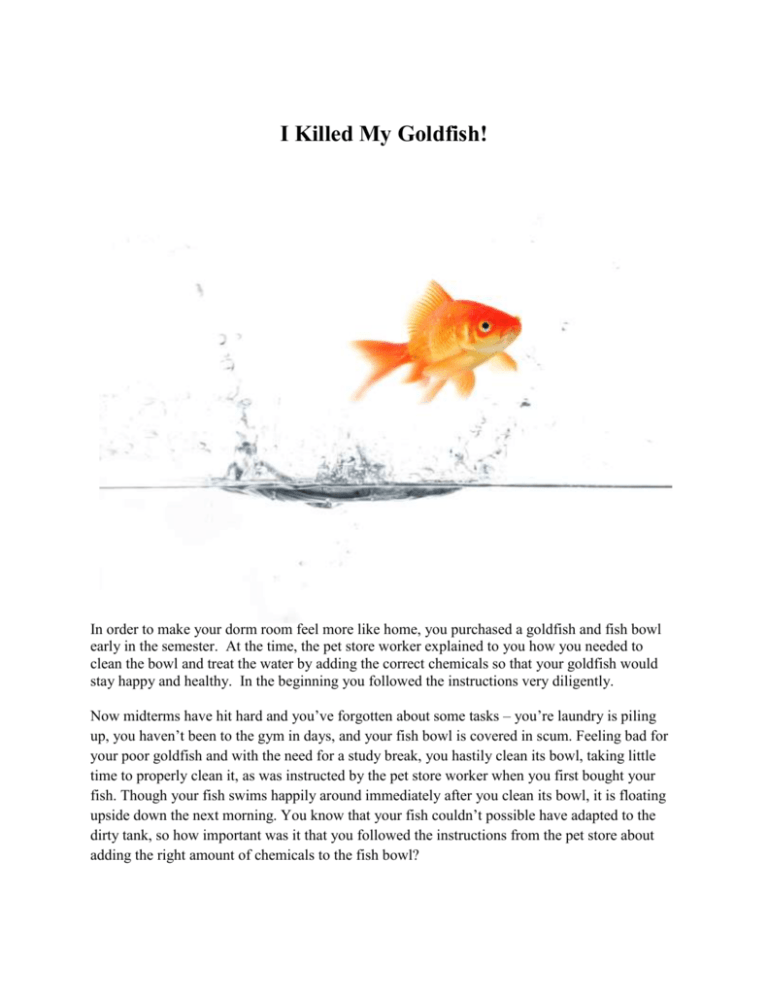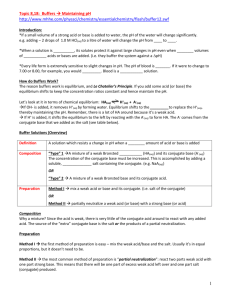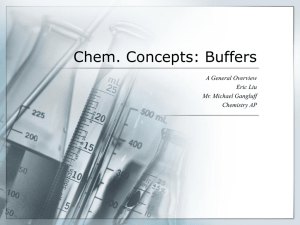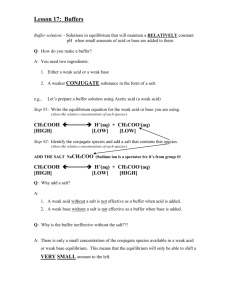Lab Handout - Skidmore College
advertisement

I Killed My Goldfish! In order to make your dorm room feel more like home, you purchased a goldfish and fish bowl early in the semester. At the time, the pet store worker explained to you how you needed to clean the bowl and treat the water by adding the correct chemicals so that your goldfish would stay happy and healthy. In the beginning you followed the instructions very diligently. Now midterms have hit hard and you’ve forgotten about some tasks – you’re laundry is piling up, you haven’t been to the gym in days, and your fish bowl is covered in scum. Feeling bad for your poor goldfish and with the need for a study break, you hastily clean its bowl, taking little time to properly clean it, as was instructed by the pet store worker when you first bought your fish. Though your fish swims happily around immediately after you clean its bowl, it is floating upside down the next morning. You know that your fish couldn’t possible have adapted to the dirty tank, so how important was it that you followed the instructions from the pet store about adding the right amount of chemicals to the fish bowl? Background Last week we determined how the pH of a weak acid or base changes depending on its concentration and how it is influenced by the equilibrium for the auto-ionization of water. This week we will be investigating how we can keep the pH relatively constant when strong acids or bases are added to a solution. This is a very important since many reactions, including most of those that occur in living things, only happen when the pH is just right to make the reaction go in the desired direction. Since most of these reactions either consume or produce H+ it is important to have a way to keep the pH steady. One way to do this is by using a buffer. A buffer is something which reduces the change when new things are added to system at equilibrium. In the world of chemistry, buffers consist of a weak acid (or base) and its conjugate base (or acid). The acid-base pair is mixed together in a ratio that produces the desired pH and at a concentration that is sufficiently large to absorb the impact of the addition of small amounts of acids or bases. The magic of equilibrium makes this possible. To prepare a buffer, a weak acid and the salt of its conjugate base are mixed together to form a dynamic equilibrium: HA ↔ H+ + A- (1) where HA is the acid, and A- is the conjugate base. When an acid is added, the influx of H+ ions causes a shift in the equilibrium to produce more acid. On the other hand, the addition of a base causes the opposite effect, in which the equilibrium shifts toward the formation of the conjugate base: OH- + HA ↔ A- + H2O (2) The same logic can be followed for a buffer comprised of a weak base and the salt of its conjugate acid. Similarly, the equilibrium will shift upon the addition of a strong acid or base. An influx of H+ ions from the addition of an acid will shift the equilibrium towards the formation of the conjugate acid, while the addition of a base will shift the equilibrium towards the formation of more base. Buffer capacity is defined as the ability of a buffer to resist a change in pH and is related to the concentration and relative proportions of weak acid and conjugate base. The capacity of a buffer to resist a drastic pH change upon the addition of an acid or base is advantageous for many chemical reactions, including those in the body. For example, the pH of human blood is highly regulated within pH values of 7.35-7.45. When the pH of the blood rises above or falls below this window, the body cannot function properly, thus a buffer must be used to remain within the narrow range of normal functioning. The effect of hydrogen ion concentration on three different buffer solutions will be investigated in this procedure. The effect of different buffer ratios, the buffer capacity, and the effect of diluting a buffer will be studied so as to discover the properties of buffers. Procedure1 1. Calibrate a pH meter with pH 7 and pH 4 standard buffers. Rinse the electrode with deionized water and wipe it with a Kimwipe between solutions. 2. Prepare your first assigned solution (table 1) in a clean test tube. 3. Transfer half of the solution to a second clean test tube. 4. Measure the pH in the first test tube. Figure 1. pH meter. 5. Add 0.5 mL of 0.25 M HCl and measure the pH again. 6. Repeat step 5 four more times until a total of 2.5 mL of HCl have been added. 7. Repeat steps 4-6 with the second test tube using 0.25 M NaOH instead of HCl. 8. Repeat steps 2-7 for the rest of your assigned solutions in table 1. Table 1. Solution preparation. solution 0.25 M your acid (mL) 1 10.0 2 5.0 3 1.0 4 15.0 5 5.0 6 19.0 7 1.0 8 20.0 9 0 10 0 0.25 M your base (mL) 10.0 5.0 1.0 5.0 15.0 1.0 19.0 0 20.0 0 H2O (mL) 0 10.0 18.0 0 0 0 0 0 0 20.0 Data Collection Copy tables 1-3 into your notebook filling in the appropriate information for your assigned acidbase pair and solutions. Table 2. Changes to pH when o.25 M HCl is added. + 0.5 mL + 1.0 mL solution initial pH pH pH + 1.5 mL pH + 2.0 mL pH + 2.5 mL pH Table 3. Changes to pH when 0.25 M NaOH is added. + 0.5 mL + 1.0 mL solution initial pH pH pH + 1.5 mL pH + 2.0 mL pH + 2.5 mL pH Calculations Include the following calculations in your notebook: 1. BEFORE coming to lab calculate the initial concentrations for both the acid and base in solution 4 or 5 for your assigned acid-base pair. 2. Calculate the Ka of your assigned acid from the pH of your solution 4 or 5. Reference 1. Adapted from Qualitative Analysis: Investigation of Buffers In Introduction to Equilibrium and Reactivity, CH-231 Lab Manual; College of the Holy Cross, Spring 2009.











